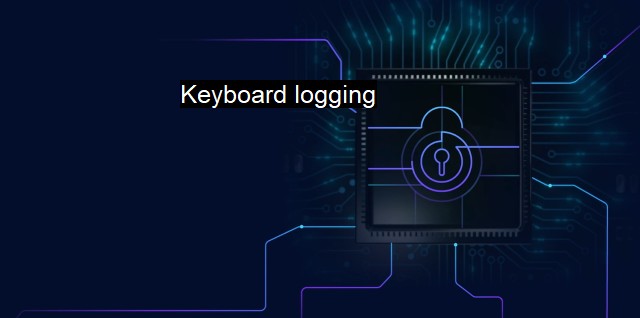What is Keyboard logging?
Understanding Keyboard Logging: Methods and Prevention Techniques for Cybersecurity
Keyboard logging, also known as keylogging, is a dangerous behavior often executed with maligned intent in the field of cybersecurity. It defines a method by which hackers, through a program or device, track and document every key pressed on a victim's keyboard. These logs can capture an array of detrimental information, such as card details, passwords, identifiers, and other forms of sensitive personal data. Let's delve a bit further into this practice, exploring how it undermines cybersecurity efforts, and why it's essential to redesign antivirus strategies to effectively counter it.Keylogging is a common tactic utilized in cyberattacks. The two primary methods of keylogging include the use of special hardware and software programs. Hardware keyloggers are devices that are attached to the keyboard's USB or PS2 connector, which then compiles a record of all button presses. Software keyloggers, on the other hand, are programs or scripts that catch keyboard strokes at an operating system level before they can be encrypted for network transmission. It's important to note that while hardware-based keyloggers are less common due to physical access requirements, they are also harder to detect.
The primary motives of keylogging are to gather sensitive data such as usernames, passwords, bank account details, and credit card numbers, constituting malicious threats to an individual's or an organization's cybersecurity. Usually, such information is silently transmitted to the cybercriminals, often encrypted, protecting billions at stake.
Due to these dangers, the significance of devices having suitable cybersecurity features that condemn keyloggers has become extremely relevant. Many advanced types of malware, such as keyloggers, are devised to bypass traditional virus detectors quickly. Hence, a progressive approach, proportional to the increasing capabilities of these cyberweapons, requires evolvement in security systems.
Antivirus software has incentivized including anti-keylogger technology in modern-day security measures to counter keyloggers effectively. They function by analyzing patterns and habits that mimic keyloggers, giving a user more security than traditional antivirus programs that fundamentally focus on outdated definitions of known viruses.
Many brands are now using cloud-based security systems that study real-time traffic and flag abnormal behavioral patterns. Universal keystroke encryption, a feature comprised by advanced antiviruses, allows keystrokes to be encrypted in real time, rendering them useless to keyloggers.
Regularly updating your operating system is also a valuable recommendation to ward off software keyloggers as most updates encrypt keystrokes and hinter the decoder. Anti-spyware software equally plays a critical role in this defense.
Within the cybersecurity context, the keyboard logging phenomenon continually threatens individual and enterprise data security. Businesses and institutions that handle sensitive information need to adopt powerful antivirus tools with anti-keylogger features to protect their data from falling into the wrong hands.
The risks from keylogging can lead to severe losses for organizations or individuals. Imagine losing all your money just because you were unaware of the keylogger in your system capturing all your keystrokes, including your banking details. Hence, it is pertinent to acknowledge the grave threat poised by keylogging and equip systems with a robust antivirus solution to combat such threats.
Keyboard logging leverages seemingly benign activities to yield perilous results. Whether used by state-sponsored attackers to target critical infrastructure, or by petty criminals aiming for credit card information, it underpins various illegal cyber activities. Therefore, its threat cannot be underestimated - making the necessity to employ advanced antivirus protocols hosting anti-keylogging features an absolute must for defending against such covert and consequential attacks.

Keyboard logging FAQs
What is keyboard logging?
Keyboard logging, also known as keylogging, is a type of cybersecurity attack where a software program captures every keystroke made on a keyboard without the user's knowledge or consent.Why is keyboard logging a threat to cybersecurity?
Keyboard logging is a threat to cybersecurity because it can capture sensitive information such as usernames, passwords, credit card numbers, and other confidential data. This information can be used by cybercriminals to commit identity theft, fraud, and other malicious activities.How can antivirus software protect against keyboard logging?
Antivirus software can protect against keyboard logging by detecting and blocking keylogging programs from running on a computer. Many modern antivirus programs include anti-keylogging features that monitor keyboard activity and block suspicious behavior.What can individuals do to protect themselves from keyboard logging attacks?
Individuals can protect themselves from keyboard logging attacks by being cautious when downloading and installing software from unknown sources, using strong and unique passwords, and keeping their antivirus software up-to-date. It is also recommended to use a virtual keyboard or password manager that can prevent keylogging attacks.| | A | | | B | | | C | | | D | | | E | | | F | | | G | | | H | | | I | | | J | | | K | | | L | | | M | |
| | N | | | O | | | P | | | Q | | | R | | | S | | | T | | | U | | | V | | | W | | | X | | | Y | | | Z | |
| | 1 | | | 2 | | | 3 | | | 4 | | | 7 | | | 8 | | |||||||